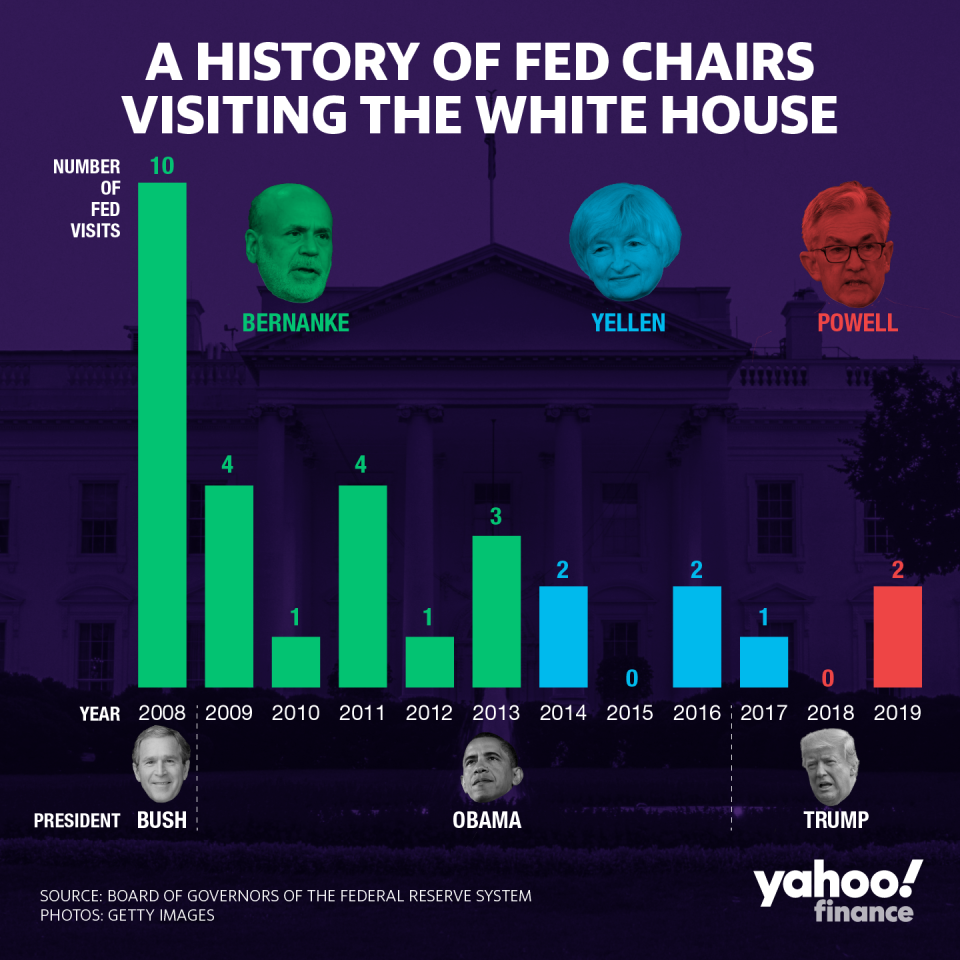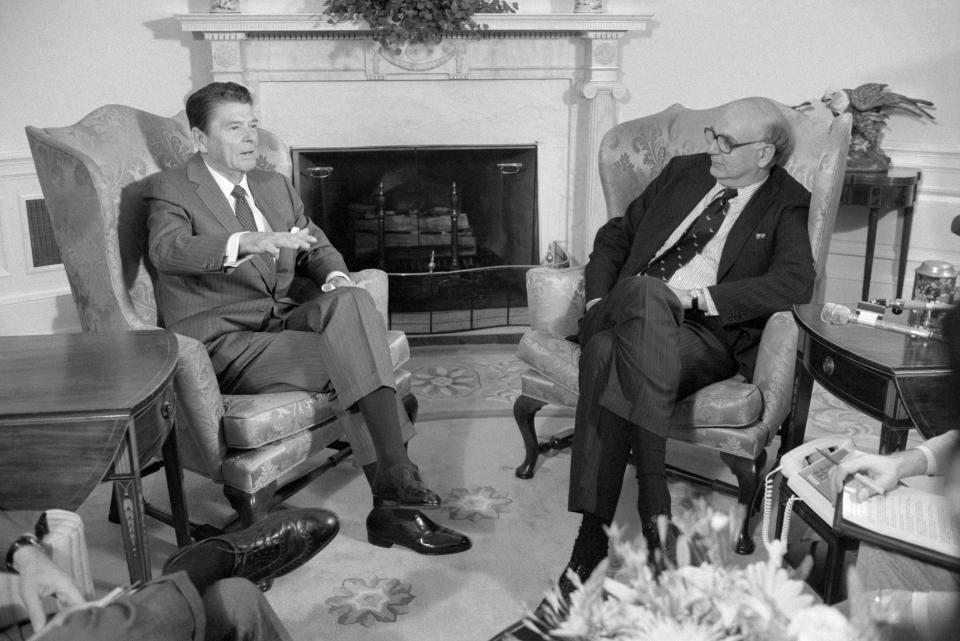A history of Fed chairs visiting the White House
Federal Reserve Chairman Jerome Powell made his way to the White House on Monday morning for an unscheduled meeting with President Donald Trump. Although Powell’s meeting is notable given Trump’s constant public berating of the central bank, meetings at the White House are far from unusual for Fed chairs of years’ past.
Powell’s predecessors usually made at least one trip to the White House each year. During the economic recovery, Janet Yellen also made a few visits to the White House. In both 2014 and 2016, she visited twice, according to official schedules published by the Federal Reserve.
In 2008, Ben Bernanke visited President George W. Bush frequently as policymakers scrambled to address the financial contagion engulfing Lehman Brothers, AIG, and Fannie Mae and Freddie Mac. Between September 16 and October 1, Bernanke made five visits to the White House as President Bush tried to scrape together a $700 billion rescue package.

Powell’s visit on Monday comes during calmer economic times, but marks his second face-to-face meeting with the president this year. In February, Powell visited Trump for dinner, shortly after the central bank teetered from a tone of steady rate hikes to “patience” on further rate moves. At the time, Trump had expressed a strong distaste for the Powell-led path of rate hikes through 2018.
Visits to the White House are not unprecedented, but Trump’s constant and public criticism of the independent institution are. Trump has berated Powell, whom he tapped to become Fed chair in 2018, as a golfer who “can’t putt” and a “bonehead,” arguing that Powell should dramatically lower rates to provide easier monetary policy to the economy.
In the past, the Fed has not followed every meeting with a readout of the topics discussed behind closed doors. But the Fed issued releases for both of Powell’s meetings this year, using nearly identical language to explain that Powell discussed “growth, employment and inflation,” but “did not discuss his expectations for monetary policy.”
After Monday’s meeting, Trump tweeted that negative interest rates and the effect of a stronger U.S. dollar were also discussed in the “cordial” meeting.
Just finished a very good & cordial meeting at the White House with Jay Powell of the Federal Reserve. Everything was discussed including interest rates, negative interest, low inflation, easing, Dollar strength & its effect on manufacturing, trade with China, E.U. & others, etc.
— Donald J. Trump (@realDonaldTrump) November 18, 2019
Ken Matheny, a senior economist at Macroeconomic Advisers, told Yahoo Finance that Powell would like to make it clear that these meetings “do not imply political influence” on Fed policy.
“Such meetings have happened in the past without an announcement from the Federal Reserve, reinforcing the impression that the Chairman intends to reassure the public that its independence from partisan issues is sacrosanct,” Matheny said.
In addition to Powell’s two meetings at the White House, Fed schedules show that Powell also connected with Trump over the phone for three brief five-minute calls in March, April, and May.
Independence ‘saves you’
What truly happened behind closed doors is up for speculation, but details of previous meetings between Fed chairs and presidents have revealed efforts to sway monetary policy.
These discussions can range from cordial to downright violent. One story tells of President Lyndon Johnson pinning then-Fed Chairman William McChesney Martin to a wall during a meeting at Johnson’s ranch in December 1965, all over the Fed’s decision to raise rates.
Former Fed Chairman Paul Volcker told a Fed historian in an interview in 2008 that he never heard if that story was true or not. But for his part, Volcker said he faced little interference from the Jimmy Carter administration. As each administration has its own style of communication, Volcker said Carter preferred to liaise with the Fed through his cabinet officials, so that “there wasn’t that much talking with the President directly.”

Under Ronald Reagan, Volcker similarly felt that he faced little pressure. But in the summer of 1984, he was called to the White House in what Volcker recalled as an effort to influence Fed policy. Volcker said he was pulled into a room (that he presumed did not have taping machines) and received an “order” from Reagan’s chief of staff not to raise rates before the 1984 election, which Reagan would eventually win.
Volcker noted that he was not about to raise rates given economic conditions at the time, but did not want to give Reagan a “yes, sir” because it could compromise his independence. Volcker claims he said nothing in response and told no one of the exchange.
“What saves the Federal Reserve in the long run is that the Congress doesn’t want the Administration to have control of the Fed, and the Administration doesn’t want the Congress to have control of the Fed,” Volcker said. “That is the unique aspect of the Federal Reserve, and it saves you.”
Brian Cheung is a reporter covering the banking industry and the intersection of finance and policy for Yahoo Finance. You can follow him on Twitter @bcheungz.
Federal Reserve officials reveal 50/50 split over October rate cut
Fed Chair Powell on economic expansion: 'No reason why it can't last'
Philly Fed's Harker: Central bank should 'hold steady for a while'
Fed Chair Powell: Negative interest rates 'would certainly not be appropriate'
‘The weirdest place in the world’: What the Fed missed in Jackson Hole
Read the latest financial and business news from Yahoo Finance
Follow Yahoo Finance on Twitter, Facebook, Instagram, Flipboard, SmartNews, LinkedIn, YouTube, and reddit.

